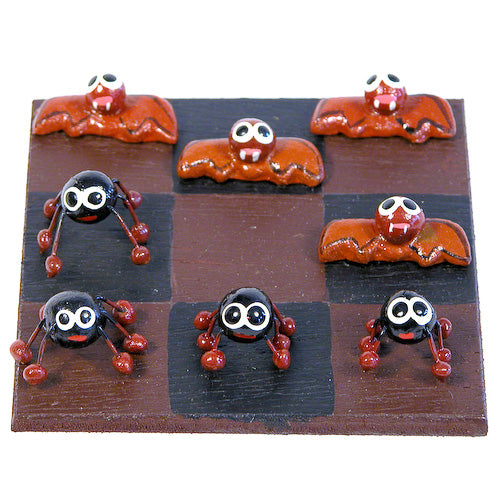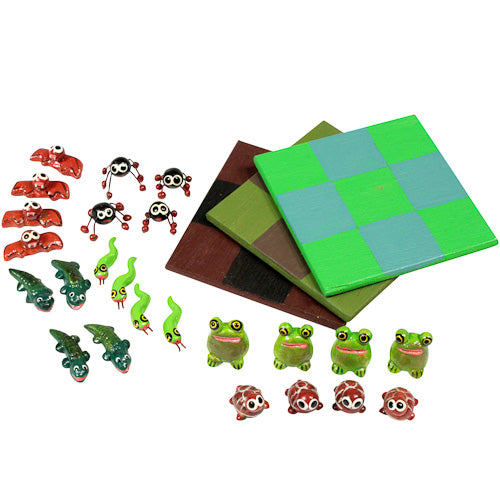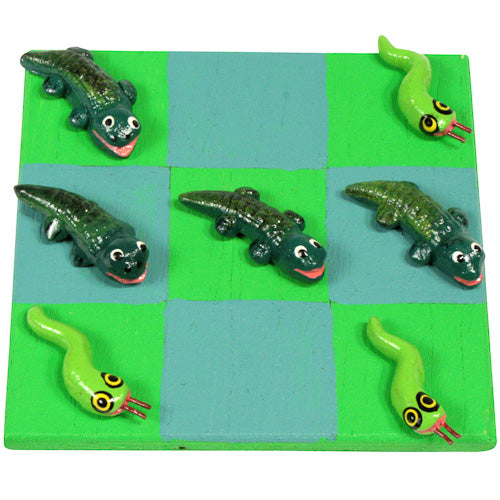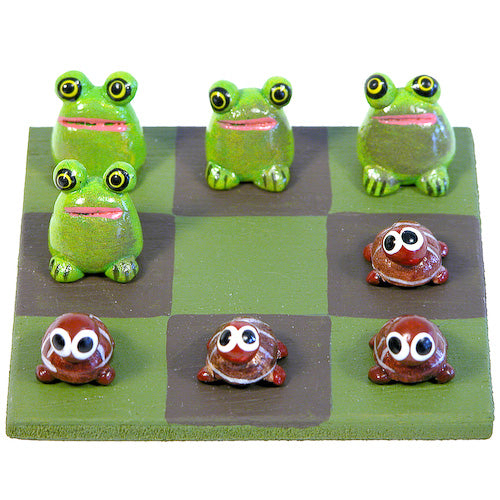OWP
Mayan Tic Tac Toe Game - Bat vs Spiders/ Serpents vs Crocodiles/ Toad vs Turtle
Mayan Tic Tac Toe Game - Bat vs Spiders/ Serpents vs Crocodiles/ Toad vs Turtle
Couldn't load pickup availability
You'll get a kick out of our handmade Tic-Tac-Toe game, hand-crafted by the artisans in Guatemala of De La Selva. A fun board game to pass quality time. A set of 8 cute animal figurines and a hand-painted board. Makes for an excellent activity on travels and picnics.
Toad: called Bab in Maya. This animal is related with the rituals of water and is considered the messenger of a goddess.
Turtle: The Mayas related this animal with water. For the Mayas, his shell symbolizes the circular shape of the earth, which was used as a musical instrument, and also to reproduce the sound of lightning proceeding the rain.
Bat: Called Tzotz in Maya, this nocturnal animal is related to death, sacrifice, and forces of darkness.
Spider: The Mayas related this insect with lxchel: goddess of healthiness at birth, pregnancy, and fertility.
Serpent: Called Caani in Maya. The deities of water and earth's fertility are believed to be related to this powerful animal.
Crocodile: In Mayan cosmology, a huge crocodile was holding the earth. The Mayans believed him to be a source of great power.
To the ancient Mayas of Guatemala, each animal represented a feeling, was related to a ritual, or was connected to the environment. Play Mayan Tic-Tac-Toe and learn about what the Mayans believed these animals represented.
- Three board designs are available: Toad vs Turtle, Bat vs Spider, and Serpent vs Crocodile.
- Each Board Measures 3-1/2” x 3-1/2”, and game pieces measure 1/4" - 3/4”.
Handmade in Guatemala and fair trade imported.
To learn more about the talented artists and the techniques they use to create these eco-friendly items, please click "About the Artisans" below.Share
About the Artisans
About the Artisans
 Joyeria Semilla meaning Seed Jewelry is a small fair-trade workshop in the Andean town of Villa de Leyva, Colombia. Girasol Taborda, a local artisan and social entrepreneur, started the workshop in the mid-1990s.
Joyeria Semilla meaning Seed Jewelry is a small fair-trade workshop in the Andean town of Villa de Leyva, Colombia. Girasol Taborda, a local artisan and social entrepreneur, started the workshop in the mid-1990s.
Joyeria Semilla’s objective is three-folds; to create new jobs, revive Colombia's handicrafts sector and to motivate locals to better manage their natural resources. The organization works primarily with socially and economically disadvantaged youths, single mothers and people with disabilities in the area. The company offers free training in product design, technical training and marketing to new members. Joyeria Semilla has trained them in the craft of jewelry-making.

Caña Flecha or “Gynerium Sagittatum” is a locally found palm tree in the regions of the Caribbean coast. The leaves from this plant are used for making jewelry, woven hats, bags and baskets. The Zenú Indians were and their descendants inherited the tradition of picking veins of the green palm leaf for weaving. These veins were made into woven hats and other products for their personal use.
The Zenú culture is said to have existed between 200BC to1600AD. With the arrival of the colonizers in the 16th century, the indigenous community declined of unknown reasons. Today a very small population remains that claims the inheritance of the almost extinct Zenú tribe. Known for their skills in the construction of major waterworks, canals and irrigation system along with being skilled goldsmiths, examples of their accomplished craftsmanship are found in various museums around the world. Their larger means of subsistence were hunting, farming, fishing and trading.
Caña Flecha is found in abundance in the region, and hence makes for a sustainable and naturally available raw material for these products. Every bit of the plant is utilized – from using in building walls and roofs in houses to food for cattle and medicinal purposes. It is from the central vein of the leaf that the fibers for weaving are obtained. After the hard surface is peeled off, the fibers are left in the sun to dry and undergo a natural tinting process; these fibers are barely about 1 millimeter in thickness and hence call for a lot of skill and patience to weave with. The dried fibers are then processed for natural coloration - some are boiled with lemon to whiten them and some are treated with mud and boiled with plantain leaves to blacken them. The designs are based on ancient motifs and mathematical representations, which are inspired by the early Zenú culture.








